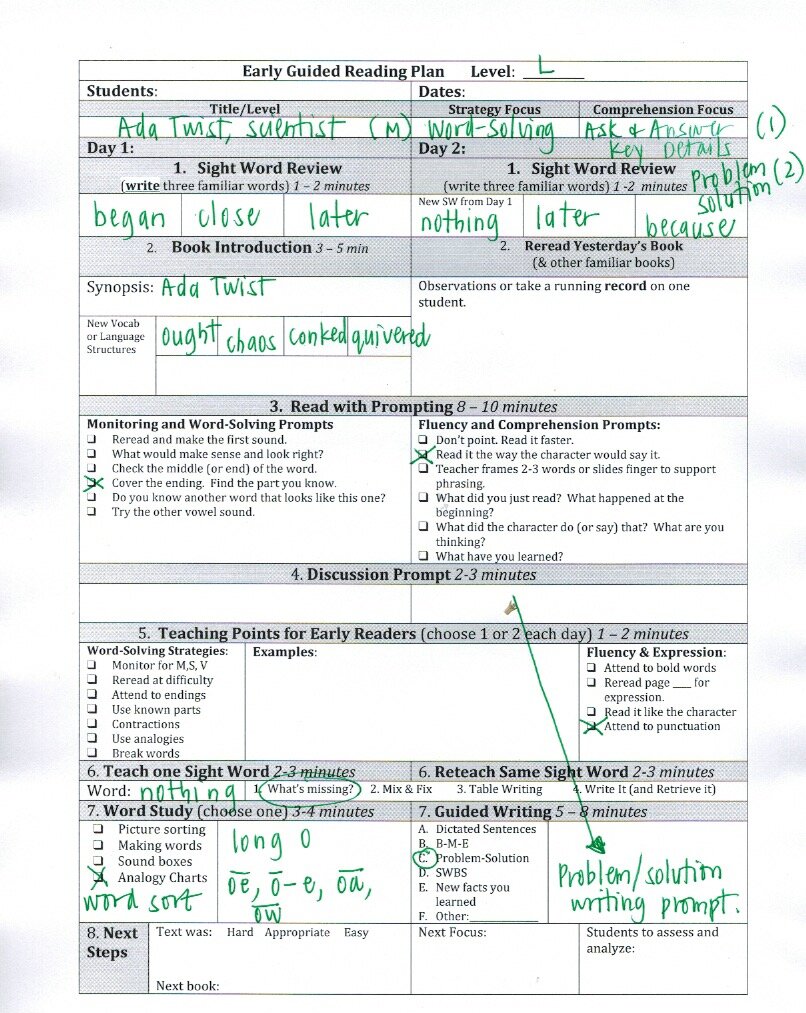Guided Reading: The e-Learning Edition
Prior to the coronavirus pandemic, it’s highly likely educators at the primary and intermediate grade levels were facilitating guided reading lessons as many as four or five days a week. As schooling has shifted to an e-learning model, guided reading lessons have likely taken a back seat. Given what we know about its benefits, I wanted to find a way to approximate guided reading utilizing technology students and teachers have accessible at home. While the example below is by no means a replacement for instruction facilitated face-to-face, the approach outlined can serve as a substitute mode of instruction as we work to manage the realities of facilitating literacy learning during quarantine.
I based the sample lesson off of a format featured within Jan Richardson’s The Next Step Forward in Guided Reading. Templates to guide instruction for Pre-A, Emergent, Early, Transitional, and Fluent readers can be found on Jan’s website. In the example below I used the Early Guided Reading template to provide instruction for a first grade reader who is at a Fountas & Pinnell level L.
The lesson was conducted using FlipGrid as the e-learning platform. To begin, I created a grid I titled “Guided Reading Sample” and then listed five topics within the grid: Sight Word Practice, Today’s Reading, Strategy Work, New Sight Word, and Word Study. The sections below outline what happens when a student accesses each topic within the grid.
Sight Word Practice:
Students are able to view a video of me instructing them to practice writing three sight words that they’ve been working on in weeks past. Each student then attempts to write each word on a piece of paper using the supplies I have indicated (marker and paper) . Next, s/he uploads a video of the work so I can see the degree to which s/he has demonstrated mastery of the given sight words. Try it here.
Today’s Reading
Each student is able to watch a video of me introducing the text of focus. Then, s/he utilizes a screen recording feature on an ipad to create a recording of her/himself reading a designated portion of the book. Next, the student uploads the screen recording to FlipGrid so I can listen to her/his reading and make note of areas of strength and areas for growth. View the introduction here. View a sample of student work here.
Strategy Work
In this portion of the lesson, I briefly introduce a reading strategy that aligns well with the group’s needs and/or the text of focus. For example, I might encourage readers to pay close attention to the punctuation inside sentences if a group has transitioned to reading books that feature more complicated sentences. See sample instruction here. See sample of student work here.
New Sight Word
The student is able to watch a short video clip of me introducing a new sight word. Within the sample lesson, I utilize a game titled “What’s Missing?” to teach the word. To play “What’s Missing?” I place magnetic letters that spell “nothing” (the new sight word) on a magnetic white board. Then I turn the board, remove one letter, and face the board for the student to see. Students are challenged to figure out which letter I removed from the sight word. To document this work, I ask students to write which letter is missing on a piece of paper and upload an image of their work. See sample instruction here. See sample of student work here.
Word Study
The student is able to watch a video during which I give directions for a word study skill. Then, s/he is prompted to complete an activity. The activity is attached to the grid. See sample instruction here.
Guided Writing
The student watches a short video with instruction on a guided writing prompt. Then, s/he completes the task and uploads an image of her completed work.
Logistics
Technology needed:
ipad, Chromebook, or laptop
FlipGrid App
Epic App OR some other way to access electronic books online (i.e. e-books via public library)
Screen Recording capabilities (see below)
Teacher:
To create a guided reading grid, visit the FlipGrid website (https://info.flipgrid.com/) and set up an educator’s account. Next, create a guided reading grid. Add topics following the example outlined above, or follow the framework utilized in your classroom prior to the transition to e-learning. When you’re ready, share the grid with students. Note: To make the process a bit less time consuming, the original grid can be duplicated and edited to include differentiated instruction for other guided reading levels.
Student:
If a student has access to a Chromebook or laptop, the screen recording feature is embedded directly within FlipGrid. When a student presses the green “add” button to add his/her response to a grid, an ellipse(…) appears. Clicking on the ellipse reveals three options: 1. Add video clip, 2. Record without audio, or 3. Screen recording. Select “screen recording” to capture the video and audio of a screen session for up to 10 minutes. When done, students should save the screen recording to the photo album of the computer and then upload to the grid. (Click through the images below to see the sequence of steps necessary.)
If a student is on an ipad, there are several ways to activate screen recording. The easiest way is to install and utilize a screen recording app. As example, an app called Screencast-0-matic is free and easy to use. Another pathway involves manually activating a screen recording feature of the ipad. This is slightly more cumbersome than using the app, but does work. Instructions are here.
Feedback
As student work is submitted to the grid, FlipGrid enables educators to leave feedback for each student in written or video form. Feedback is only visible to the individual who submitted the work. Students can access the feedback by checking the FlipGrid website, or you can initiate an email sends feedback directly to each student. Additionally, one could provide feedback to students directly if/when conducting a weekly check-in via Zoom or Google Hangout.
Closing
The benefit of this model of e-instruction is that it enables educators to keep a finger on the pulse of each student’s reading development. Utilizing books from Epic (or another electronic reading platform) ensures that students have access to texts that are at the instructional level of their development. Having the opportunity to hear students read (via screen recording) enables teachers to tailor instructional feedback to the specific needs of each learner. Given the unknown length of the season of e-learning that is suddenly upon us, it seems wise to build clear connections between students’ reading practice and our instructional practice.




